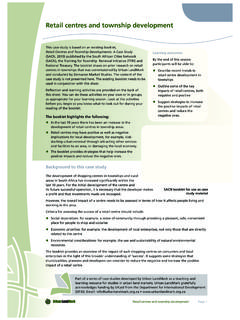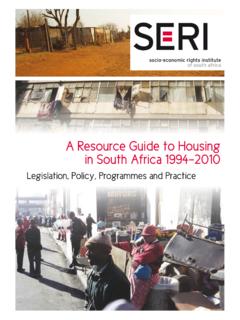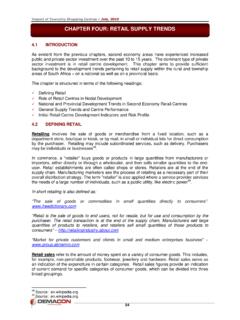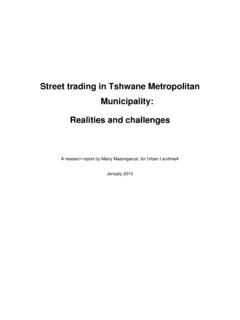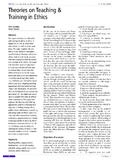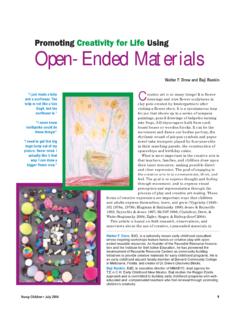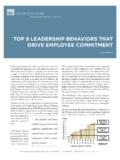Transcription of 2. LAND MANAGEMENT IN SOUTH AFRICA - Urban …
1 12 Synthesis What is land MANAGEMENT ?Traditionally land Use MANAGEMENT , its systems, devices, and regulations were used in the service of racial and spatial segregation in SOUTH AFRICA (Bollens, 2005). The aims of the Apartheid system were for the most part carried out through the dire efficiencies of the planning legislation and its implementation, which maintained spatial segregation and en-trenched a racial hierarchy through reserving the provision of rights and services for the white minority. The irony of the Apartheid land MANAGEMENT systems were that they worked , in the sense that the goals and objectives of the Apart-heid system were for the most part successful. That is not to say that pockets of resistance did not occur and that as the old regime was drawing to a close more and more areas greyed (McCarthy, 2006). Johannesburg, like its Urban siblings, was configured and reconfigured using the tools of planning that were at the disposal of the local authorities, in order to ensure it conformed to the segregationist and racist thinking of the government of the day.
2 The efficiency of the system can be clearly seen in the histories of the sites under discussion. The formal cadastre and the modernist planning of Hillbrow effectively attracted the white aspirant classes it was intended to from 1950s onwards (Silverman and Zack, 2007). The same can be said of Berea, whose more suburban landscape, with its lower densities and range of facilities attracted white, nuclear families in the 1960s and 1970s. In both cases the zoning laws and layout achieved their ends: regulated, modern spaces set aside for middle class white families and providing access to employ-ment and facilities. By the same token, spatial laws in other parts of the City maintained and encouraged segregated spaces in which black SOUTH Africans could effectively be denied any form of franchise. Urban planning with intended divisive outcomes was disguised and camouflaged under a wide variety of linguistic and semantic euphemisms.
3 Almost from the beginning of Johannesburg s establishment the non-white population was displaced and re-settled in ways that were depicted as being for their own good . Beavon (2004) argues that planning and land MANAGEMENT tools were sometimes conceptualised and portrayed as essential elements of health and safety, as necessary for creating order out of chaos and ensuring that non-white populations lived in more hygienic locations. The end result, however, was a land MANAGEMENT system that effectively de-humanised a wide sector of the SA population (Himlin, et al, 2007; Hoosen and Mafukidze, 2007). Although Apartheid land MANAGEMENT systems did work for certain agents at certain times, they were not completely successful (Sapire, 1992; Crankshaw, 1993). They worked in the sense that Apartheid planners could claim large swathes of land were dominated by one race group, and one rates base or another; and that the minimum services, facilities and expenditure on infrastructure was certainly apparent in the black areas of SOUTH AFRICA .
4 The groups who were on the losing end of the land MANAGEMENT policies protested and contested these spaces through open opposition protests, riots, and illegall occupation of land or subversively, by quietly infiltrating and staying in areas that they were barred from (Sapire, 1992). In the late 1980s, the dissolution of certain Apartheid policies reflected a slow departure from the earlier stance of absolute legal enforcement. Some areas, such as Hillbrow, Berea, Yeoville, and the Johannesburg CBD, rapidly changed their racial demographics as the Apartheid system began to crumble and there was a need for greater access to the economic opportunities of the city (Beavon, 2004).In the post-Apartheid era there has been a directive to ensure that all parties benefit from land and its multiplicity of uses (Bollens, 2005). In 1993, new thinking in land use came to the fore within what was the old Central Witwatersrand Region: the Central Witwatersrand Metropolitan Chamber (CWMC) developed the Interim Strategic Framework, which empha-sized the fact that thinking around land use must change: The ISF must [.]
5 ] seek to engender the patterns of Urban complexity that under-mine the strength of exclusionary areas (and hence conflict) and actively seek the blurring of zone boundaries and the integration of hitherto isolated areas into the mainstream of the Urban system . (CWMC, 1993)2. land MANAGEMENT IN SOUTH AFRICA13 Synthesis ReportLand MANAGEMENT and Democratic Governance in the City of JohannesburgPost-Apartheid thinking about land MANAGEMENT noted that cities needed to be densified and buffer zones infilled , whilst upgrading and renewing areas that had previously been ignored or disregarded. To add to the challenge, all of these new land MANAGEMENT activities were taking place in an environment where land and housing policy and legis-lation were being rethought and re-written (van Wyk, 1999). There were in fact many prongs to the rethinking of cities and the use of space, which impacted on land MANAGEMENT systems.
6 Greater emphasis was placed on secure tenure, ownership, and title both as a way of the ANC entrenching its position within the hearts of a number of the previously dispossessed (Charlton and Kihato, 2006). At the same time there was an attempt to restructure the housing and property markets, through the national housing programme and its various subsidies (McCarthy, 2006). Privatising Council hous-ing and publicly owned land had two main objectives: the first was to make sitting tenants and people of record into property owners, with the hope that home ownership would contribute to their socio-economic upliftment. The second aim was to try and ensure that municipalities and provincial governments divested themselves of the financial drain of maintaining the stock, administering rental collection and writing off any losses due to non-payment (Morkel, 2005). SOUTH AFRICA s political history has resulted in the development of Urban landscapes that are enormously socially and spa-tially inequitable; a further significant Urban feature is the existence of a number of uni-purpose nodes and settlements.
7 Townships were essentially considered large dormitories, which intentionally lacked any business or recreational activi-ties, and certainly no office parks. New legislation, regulation and policy had to be put in place to ensure that Apartheid cities were transformed into spaces of equity, integration, and sustainability. This meant a significant change to the way land was thought about, regulated and have been a number of consequences to this change in land MANAGEMENT approaches, which have had to re-spond to the new directives, pragmatic and technical challenges and new international and global forces. The five case studies that were undertaken in Johannesburg offer a great deal of insight into what has happened on the ground and within the institutional environment in terms of land use MANAGEMENT in the City. They have thrown light on a range of processes that are happening at a range of levels and with a variety of actors.
8 What follows is an analysis of the major themes and commonalities that the studies have thrown up, followed by a series of recommendations taken from the work and its Current land Use MANAGEMENT : An OverviewOne of the issues that becomes clear from the outset when examining land MANAGEMENT in SOUTH AFRICA is the vast array of land use MANAGEMENT and planning legislation. At the national level, there is an uninviting range of policy that has come to pass over the last 14 years. The wide variety of Acts include the tenets of the Constitution and its requirements and obligations regarding housing, land , property, and the principles of social justice (Ovens, et al, 2007); the Develop-ment Facilitation Act of 1995; the Housing Act (1997); Housing Code (2004); the Municipal Systems Act (2000); the various shades of papers from Green to White of Development and Spatial Planning (2001); and the land Use MANAGEMENT Bill (2006)2.
9 Each of which purports the noblest of intentions: to create Urban areas that dispel and rid cities of Apartheid s segregated planning ideals, and reconstruct cities of integration and equal economic and social opportunity (Ovens, et al, 2007).Although policy has proliferated at a national, local level and micro level, .. there has been little advancement and in-novation in thinking and practice around land MANAGEMENT , and SOUTH AFRICA s towns and cities continue to develop without an adequate framework for managing land development in a way that supports the goals of democracy, equity, efficiency and sustainability (Ovens, et al, 2007). There is a general sense that little has been done to change underlying considerations and foundations upon which legal, regulatory and policy thinking has been laid. Berrisford (2006) and Parnell (2007) both argue that the current land MANAGEMENT systems are effectively inimical to many of the goals of the post-Apartheid state and are obstructive in providing the poor with access to land or supporting activities that effectively maintain and/or better their quality of life.
10 There are other problems facing land MANAGEMENT and, at a far more pragmatic level, there is a lack of capacity within municipalities to actually cope with land MANAGEMENT systems. The lack of capacity occurs in two forms: the first is the 2 For a full discussion of each, please see Ovens, et al, 2007 overview reportLand MANAGEMENT and Democratic Governance in the City of Johannesburg14 Synthesis Reportshortage of people with appropriate qualifications in land MANAGEMENT to deal with the current demand. Those who are professionally qualified are often shuffled to other positions, leaving the least qualified to deal with complex policy and technical requirements for which they have neither the training nor the skill (Berrisford, 2006). The second aspect is the inability of those in the planning departments to have the time to access the newer legislation and to be trained in its application and implementation.
